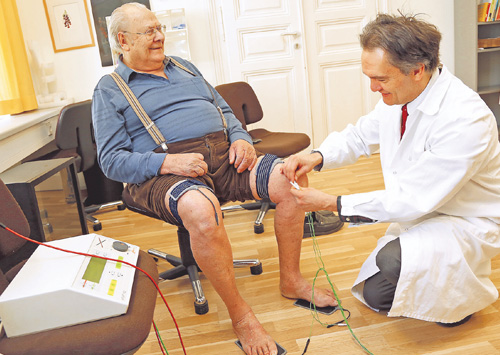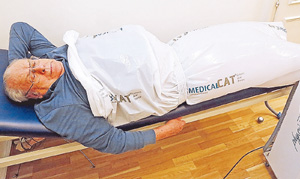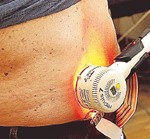“I thought one would get used to it,” but the pains made life hell for the Viennese pensioner. Only a special program brought the long-awaited relief.

At the provisional end of the story was a ladder. Horst used it to retrieve something from a high shelf in his hobby shop. Unfortunately, he also fell down with it. Result: shattered heel bone, injured ankle, and affected hip. That was five years ago. No wonder the healing process was slow, as the aftermath of the accident was compounded by already damaged spinal vertebrae, rheumatism, osteoporosis, and constant back pain. Even a long time after the accident, which added to his existing problems, the pain was intractable. “I thought I would get used to it and I just had to somehow drag myself along,” Horst resignedly thought, but his wife looked for alternatives. She read about red light therapy and persuaded Horst to try the treatment. They ended up with neurosurgeon and pain specialist Dr. Reinald Brezovsky from Vienna, who has extensive experience with non-invasive methods. “The basic treatment consists of ten to twelve sessions. Initially with muscle stimulation, then also with cold red light and carbon dioxide in the form of dry baths,” explains Dr. Brezovsky. “Best results are also seen in diabetics and vascular diseases. Even amputations can sometimes be prevented with consistent use.” The combination of different applications quickly brought improvement. “The therapy is doing me a lot of good! After the first sessions, the complaints subsided. I hike with walking sticks, but I can now manage shorter distances without a walking aid,” Horst is satisfied. His wife smiles happily – she sits in the treatment room next to him, chatting with other sufferers. Dr. Brezovsky has had good experiences allowing patients to interact with each other. In doing so, they learn that they are not alone with their complaints and how others deal with them. The 60-year-old Elisabeth had struggled with infiltrations for a year due to her nerve pain “without significant effect,” as she says. Moreover, she could not work, walk, or lie down without painkillers: “The medication also harmed my kidneys.”

Elisabeth is “wired” to the high-tone therapy device, while Horst lies in an inflated plastic bag filled with carbon dioxide, letting the gas work its magic. It penetrates even the smallest vessels, increasing oxygen supply and relaxing muscles. A positive influence on mood has also been documented. The cuffs that Dr. Brezovsky is fitting Horst with in our top picture are needed for the high-tone therapy. In addition to metabolic stimulation, they relieve muscle tension through medium-frequency, specially modulated alternating current forms. In the room, there’s also a younger man and a couple who are also affected. The mood in the small group is cheerful and relaxed – hard to believe, considering they all suffered for many years from neuropathies with chronic complaints. One patient says, “I’ve been to 20 different doctors, suffered from depression. Everywhere you are just told to accept the suffering. But I say no – I want to do something about it…”
Nerve Pain and Therapy

Polyneuropathy affects the peripheral nervous system and leads to muscle weakness, sensory disturbances, motor problems, and various degrees of pain. Besides the nerve damage itself, diabetes, vascular and immune diseases, as well as rheumatism are common causes. High-tone therapy: Muscle stimulation with alternating current forms. It relaxes muscles and promotes regeneration. Nerve Pain and Therapy Cold Red Light (REPULS): Light of this specific wavelength (634 nanometers) reduces inflammation. Carbon Dioxide Dry Baths: They affect blood circulation and oxygen supply to the tissue. Combined with high-tone therapy, they enhance the regenerative effect.
Kronen Zeitung, June 20, 2015, by Karin Podolak
